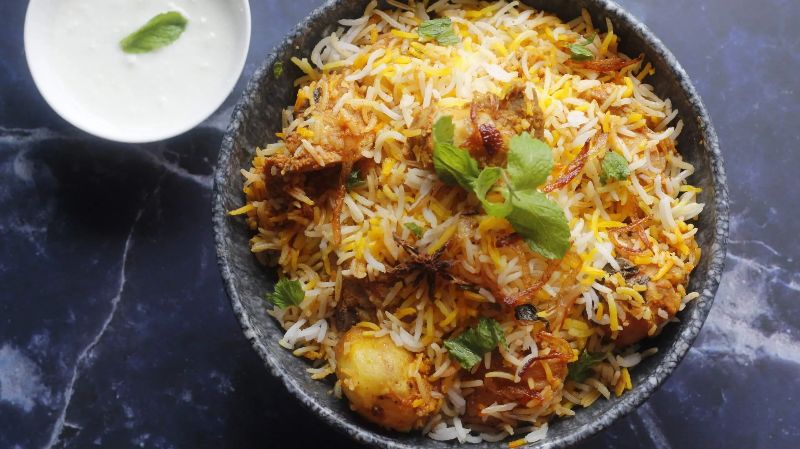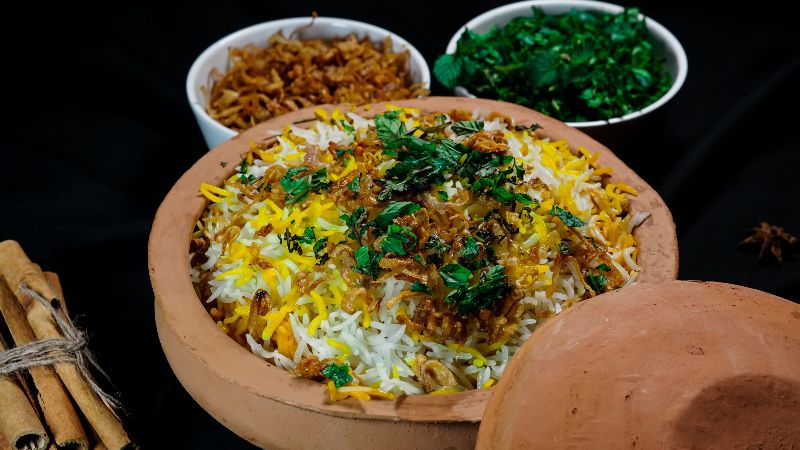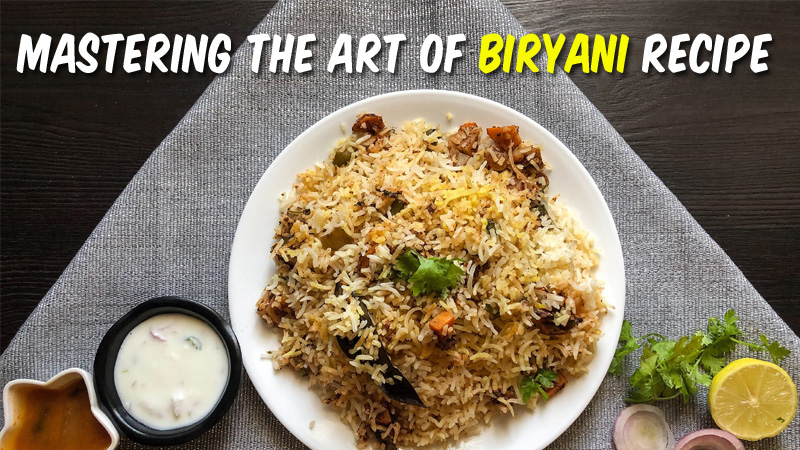Namaste, my fellow food enthusiasts! Today, we are going to aromatic realms of Biryani, a tale that spans generations and cultures. Originating from the heart of the Indian subcontinent, Biryani has evolved into a global treasure, beloved by connoisseurs and food lovers alike. Picture this: a symphony of fragrant rice, tender meats, vibrant vegetables, and an intricate tapestry of spices, all coming together to create a melody of flavors that dance on your palate.
Decoding the Biryani Styles
Ah, Biryani – a canvas painted with regional flavors. Imagine the Lucknowi Biryani, a delicate and fragrant masterpiece; the fiery Hyderabadi Biryani, known for its spirited spice; the Kolkata Biryani, a play of aromatic spices and potatoes; and the Sindhi Biryani, blending the legacies of Mughal and Sindhi cuisines.
But hold on, it doesn’t end there! Fusion and modern variations have emerged, harmonizing with diverse tastes. Behold the Chicken Tikka Biryani, infusing smoky chicken tikka essence into the rice; the Paneer Biryani, a vegetarian marvel replacing meat with velvety paneer; and the Quinoa Biryani, an ode to health and taste, offering a vibrant alternative to the classic.
The Art of Ingredients
Now, my friends, let’s dive into the essence of Biryani. Picture this as an artist’s palette, each ingredient a stroke of flavor. The Basmati rice – a canvas of long grains and an aroma that speaks of tradition. The protein – Chicken Biryani with its tender grace, Mutton Biryani with its bold embrace, and Fish Biryani, a nod to the ocean’s bounty.
The melody of spices – cardamom, cloves, cinnamon, entwined in harmony; saffron and rose water – the fragrance of luxury; and the Biryani masala – a symphony of flavors. Onions and tomatoes bring depth, yogurt adds tangy creaminess, while mint and cilantro dance in freshness. And behold, fried onions and raisins, delivering delightful sweetness.
Rice’s Culinary Overture
Ah, preparing the rice – a culinary overture that sets the stage. Soak the Basmati rice, let it rest, let it dream for 30 minutes. Rinse it well, let the excess starch bid adieu. And the water – a cup and a half for every rice cup. It’s like a poetic rhythm, the rice-to-water ratio. Cook it to a tender balance, not mushy but oh-so-fluffy.
To steam or to boil – that’s the question. Both paths lead to the essence, but steaming grants a delicate touch. Infuse flavor by adding cardamom pods or cinnamon sticks to the cooking water, like a whispered secret shared with the rice.
The Meat’s Melodic Marinade
Ah, the meat – the soulful note in this grand symphony. Marinate it, let the flavors dance and fuse. Yogurt is your base, tenderizing and tangy. Spices like cumin, coriander, turmeric, ginger-garlic paste – they’re the notes that create harmony. And the magic touch, a hint of raw papaya or pineapple juice, turning meat into a tender ode.
Crafting the Biryani Masala
To craft the Biryani masala, it’s a tale of homemade tradition versus convenience. Both roads lead to flavor, but homemade offers a journey of spice discovery. Roast and grind the spices, unlocking their essence. Imagine cumin, fennel seeds, black peppercorns, dried red chilies – a chorus of aroma and taste.
And there you have it, my fellow seekers of flavor – the beginning of our Biryani adventure. Stay tuned as we delve deeper into the secrets and techniques that shape this timeless creation, each step bringing us closer to the heart of this culinary masterpiece. Until then, keep those spices dancing and those taste buds tingling!
Layering for Harmony
The art of layering in biryani is like weaving a tapestry of flavors. Choose your vessel wisely – it’s the conductor of heat, ensuring a harmonious symphony. Start by alternating layers of par-cooked rice and marinated meat, letting them mingle in flavorful harmony. And don’t forget the saffron-milk strands and crispy fried onions – they’re the crescendos that elevate the experience.
Airtight Seals and Techniques
Sealing secrets preserve the melody within the biryani. Traditionally, dough creates an airtight embrace, while foil stands as a modern accomplice. Now, let’s talk cooking methods. Stovetop or oven, both are worthy stages. Simmer or bake – the essence is uniform cooking and intensified flavors.
Dum Cooking – A Melodic Slow Dance
Ah, the Dum cooking technique – a slow, melodic dance of flavors. Seal the vessel tight, let the steam weave its magic. The result? A biryani that’s rich, aromatic, and thoroughly indulgent. The seal retains moisture, ensuring fluffy rice and succulent meat. This technique marries the flavors to perfection, an experience you’ll savor.
The Traditional Charm of Degi Biryani
Enter the traditional Degi Biryani – a tale of slow-cooked magic. A grand deg pot becomes the stage for this symphony. It’s a slow dance of layers, each note fusing into the next. Sealed and patient, this biryani brings forth tender meat and rich flavors, capturing the essence of tradition.
Hyderabadi Biryani: An Iconic Tale
Hyderabadi Biryani, a legend in itself! Born in Hyderabad, it has etched its mark worldwide. Kacchi Biryani, a signature style, marries raw meat and partially cooked rice. The result? An enchanting melody of fragrance and flavor. The finale? Cooking it dum-style – a slow embrace of flavors that sings on your plate.
Raita and Salan: Harmonious Accompaniments
Ah, the perfect partners for biryani – raita and salan. Raita’s cool, tangy notes dance in perfect harmony with biryani’s richness. Cucumber and mint raita cools the spice, while onion and tomato raita adds a tangy crunch. And then there’s the fiery mirchi ka salan and the aromatic bagara baingan – salan symphonies that bring depth to the melody.
Biryani Recipe in Chef’s Style

Tips from the Connoisseurs
Mastering biryani demands wisdom from the maestros. Balancing spices is your tuning – let no note overpower the others. Rice’s texture is your crescendo – follow the rice-to-water ratio and cook to perfection. Slow cooking is the secret behind the magical flavor blend – patience, dear friends, rewards with an authentic aroma that lingers.
Homemade Vs. Restaurant Magic
Creating biryani at home grants artistic freedom. But if you crave the restaurant magic, unveil the secrets. Larger, sealed vessels create restaurant-style flavors and textures. The artistry of technique can turn your kitchen into a restaurant stage.
Innovations and Fusions: Biryani Unveiled
Biryani’s journey doesn’t stop at tradition. It ventures into innovation and fusion, enchanting global taste buds. It’s a canvas for creativity – imagine biryani with a twist, a touch of something new. This culinary tale unfolds, each chapter a celebration of flavors old and new. Stay tuned, fellow flavor explorers!
And behold, the biryani tale takes a surprising turn with its stuffed chapters. Biryani-stuffed bell peppers and tomatoes take center stage, proudly flaunting the versatility of this cherished dish. These vessels of flavor hold the heritage of biryani, embracing new forms with open arms.
Yet, biryani’s influence knows no boundaries. Crossing seas and borders, it gracefully enters the realm of international cuisine. The essence of biryani harmonizes with the likes of biryani risotto, where Italian romance blends with Indian spices in an enchanting dance. Ever imagined the marriage of biryani with tacos? Biriyani tacos bring a spicy Latin twist to the aromatic melody. And if that isn’t bold enough, let’s talk sushi rolls – biryani-inspired rolls that reflect the global symphony of flavors in one delectable bite. Truly, biryani’s journey is a fusion fiesta that ignites taste buds worldwide.
Must Read : Master Restaurant-Quality Malai Kofta Recipe at Home 2023
Common Biryani Mistakes to Avoid
The dreaded specter of overcooked rice looms large, threatening to transform the dish into a texture disaster. Vigilance is key – monitor cooking time and hold the rice-to-water balance sacred to evade this mushy predicament.
But wait, the tale of inadequate marination unfolds. Rushing through this essential step can lead to lackluster meat that fails to harmonize with the spices. Grant the meat its due time in the marinade – a sacred ritual that results in tenderness and flavor fusion.
The symphony of spices, when not orchestrated with precision, can orchestrate a cacophony that overshadows the melody. To avoid this discord, meticulous measurement and tasteful interventions during cooking are your allies.
And let’s not overlook the crucial role of meat quality. Casting aside this criterion can have a resounding impact on taste and texture. Opt for the finest, freshest meat to ensure a crescendo of flavors.
Navigating the Biryani Bumps
In the grand journey of biryani mastery, some bumps along the way are inevitable. Fret not, for solutions abound to troubleshoot these biryani dilemmas.
Sticky rice, the bane of many a biryani enthusiast, can be tamed by a gentle rinse under cold water. This act banishes excess starch, restoring rice to its rightful, separate glory. A playful fluff with a fork can further separate any rogue clumps that dared to form.
Seeking the balance of spice can be a daunting task, but fear not – post-cooking adjustments are your secret weapon. A touch of saffron soaked in milk or a whisper of lemon juice can weave magic, enhancing flavors without stealing the show.
When faced with undercooked meat, a simple remedy lies in patient simmering over low heat. Allow the meat to bask in this gentle warmth, transforming it from toughness to succulence.
Lastly, if the biryani’s mood is too damp, unveil its lid and let the steam dance away for a few moments. This liberation from excess moisture steers you back to the realm of perfect texture.

The Bottom Line
As the curtains fall on our biryani saga, remember that crafting biryani mastery requires precision and passion. Each step is a brushstroke on the canvas of flavor, an ode to the senses.
Embrace the mantra of practice and experimentation to elevate your biryani craft. With each endeavor, you’re refining your symphony, creating a biryani that’s uniquely yours. With time, devotion, and a dash of confidence, you’ll unfurl the tapestry of aromatic artistry on every plate.

